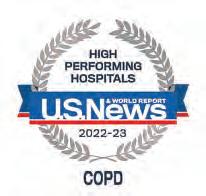




ProvidenceAlaskaMedicalCenterhasonceag providerinAlaska.U.S.News&WorldReport,theglobalauthorityinhospitalrankings, hasnamed ProvidenceAlaskaMed categoriesincludingheart attackandstroke.










Thankstothegreat workofallourcare enablingustoserveourcommunitywithaward-winningcare.
Learnmoreat Providence.org/PAMCawards
ProvidenceAlaskaMedicalCenter,anationallyrecognizedtraumacenterandAlaska’sonlyMagnethospital,ispartof ProvidenceSt.JosephHealth,anot-for-profitnetworkofhospitals,carecenters,healthplans,physicians,clinics,home healthservices,affiliatedservicesandeducationalfacilities.FormoreinformationaboutPAMC,visitalaska.providence.org.
Overthepasttwodecades,treatmentof venousinsufficiencyandvaricoseveinshas evolvedfrompainful,vein-strippingprocedures tosafe,minimallyinvasiveproceduresdonein theofficewithnodowntimeandminimalpost-op discomfort.

“Iremembervisitingmymotherinthehospitalfor fourdayswhenshehadherveinsstripped,”recalls Dr.Artwohl.“Today,wetreatnursesthatworka 12-hourshiftthedayaftertheirprocedure.We recentlytreatedanairlinepilotwhoconducteda flightlessthan24hoursafterhisprocedure.”
einsarethebloodvesselsthat returnbloodtotheheart.
Forthelegs,thisisabitofa problembecausemostofthetimeourlegs arebelowtheheartandthevenousblood flowmustflowupwardagainstgravity,” saysRobertArtwohl,M.D.
“Ourveinsareequippedwith one-waycheckvalves.Thisensuresthe venousbloodinourlegsflowsuptoward theheartandnotdowntowardsthefeet. Ifthevalvesfail,bloodflowsdownward forlongerthannormal,andwecallthis venousrefluxdisease.Thisisassociated withelevatedvenouspressurethat causessymptomssuchaslegachiness, swelling,pigmentationchanges,and canevenleadtoopensoresoftheskin. Acharacteristicofvenousdiseaseisthat
thesymptomstendtogetworseastheday goeson.”
Venousrefluxdiseaseisalsoreferred toasvenousinsufficiencyorvenous hypertension.Itisthemostcommon vascularproblemtreatedtoday.

Venoussymptomscanbeassociated withanythingfromtiny“spider”veins tolarge,bulgingvaricoseveins,butthey canalsobepresentwithoutanyapparent abnormalveinsatall.“Wefocuson symptoms,notjusttheveinsthemselves,” saysDr.Artwohl.“And,ofcourse, somepatientsaremoreconcernedabout cosmeticissues.Wedealwiththataswell.”
Notalllegdiscomfortorswellingis duetovenousrefluxdisease.Dr.Artwohl oftenrulesoutvenousissuesandgetsthe patienttotherightspecialist.
Dr.ArtwohlgrewupasanAirForcebratand spenthisformativeyearsinWashington,D.C., Madrid,andRiodeJaneiro.Hegraduatedfrom theUniversityofMarylandSchoolofMedicine, andalsodidhissurgicalresidencythere.A successfulgeneralandvascularsurgeoninAlaska since1997,Dr.Artwohlnowdedicateshispractice exclusivelytothetreatmentofvenousdisease.He iscertifiedbyTheAmericanBoardofSurgery.


Publisher: Andy Pennington
Section Editor: Nina Wladkowski
Ad Director: Eric Groves
Sales: Ryan Estrada, Adam
Garrigus, Victoria Hansen, Joleesa
Stepetin, Erika Watsjold
Advertising Operations: Lisa McGuire
Graphic Designer: Jian Bautista
Graphics Manager: Michael Oldroyd
This special publication was produced by the advertising department of Anchorage Daily News. The ADN newsroom was not involved in its production.
I have struggled with stomach issues for many years. Is it possible my upset stomach can be an allergy or sensitivity to certain foods? I want to feel better, and I am curious about testing that may be available to identify food sensitivities and food allergies.
Gastrointestinal issues are challenging, and it can be difficult to identify what may be causing you distress. It is important to recognize that food allergies and food sensitivities are not interchangeable terms.
A food allergy is the body’s immune response where an immunoglobulin E antibody, also known as an allergy antibody, binds to an allergy cell. The allergy cell releases chemicals, namely histamine, that causes a reaction — typically within a few minutes. Though rare, there is the possibility of a delayed reaction of up to two hours after time of contact with the allergen. The most typical allergic reactions include itching, hives, rash or an anaphylactic reaction, where breathing becomes impaired.
Approximately 32 million people in the U.S. have food allergies. The most common allergens are peanuts, tree nuts, fish and crustacean shellfish, wheat, soy, sesame, milk and eggs.
When someone has difficulty processing or digesting a food properly, that is known as a food intolerance or food sensitivity. Intolerance occurs in the intestines, and it is related to how people break down components or enzymes of what they eat. Lactose intolerance, for instance, is a common food sensitivity. People who are sensitive to lactose do not have enough enzymes to break down the lactose in food and beverages, which will cause symptoms. Use a food diary to track what food you had prior to having symptoms. If you note anything in your diet that is different, try taking it out.
There is no immune response in a food intolerance or sensitivity, and it does not harm a person. But it can be uncomfortable. Symptoms can include extreme bloating, fullness, abdominal pain or cramping, brain fog, headaches and altered stool patterns of loose stools or constipation.
IN MOST SITUATIONS, A FOOD ALLERGY WILL CAUSE A MORE IMMEDIATE REACTION; WHEREAS, FOOD SENSITIVITIES MAY DEVELOP OVER TIME — ANYWHERE FROM 30 MINUTES UP TO FOUR OR FIVE HOURS LATER, WHICH IS THE AVERAGE TIME IT TAKES FOR FOOD TO MOVE FROM THE STOMACH.
It can be challenging for some people to determine if they have a food allergy or a sensitivity, and a health care professional should make the diagnosis.

The gold standard of allergen testing is a skin test, where a small amount of an allergen is placed on the skin — typically on the back or forearm. Next the skin is gently scratched to introduce the allergen into the skin. Within 10-15 minutes, histamine is released, and a red bump will appear if there is possibly an allergy. The size of the redness and bump determine if an allergy is present and the severity.
A trained allergist should perform food allergy testing. Some patients may undergo an immunoglobulin E antibody food-specific blood test. Although this can help identify an allergy, this test alone does not mean there is a food allergy and an allergist should interpret the lab results to confirm.

No single test is available for food sensitivity or intolerances. Although many tests are advertised, the recognition that there is not one test is a statement supported by the American Academy of Allergy Asthma & Immunology, the Canadian Society of Allergy and Clinical Immunology and the European Academy of Allergy and Clinical Immunology.
The advertised food sensitivity kits typically use what is known as an immunoglobulin G antibody assay to test if a person has food sensitivities. These companies claim that if foods high in immunoglobulin G that were tested are removed, symptoms will improve for multiple conditions. An immunoglobulin G antibody is a memory antibody, and it determines exposure to a food — not an allergy, though some research shows that higher levels of immunoglobulin G4 are associated with better tolerance to foods.
When you are unable to find answers or want to find a way to treat symptoms without medication, it can be frustrating. However, research does not support immunoglobulin G food sensitivity tests.
Food sensitivity or intolerance testing can lead to unnecessary food restrictions, increased stress and anxiety surrounding food, fear of foods, as well as overall poor nutrition and wellness. Also, these tests may lead to misdiagnosis of possible underlying conditions. And in some cases, they may worsen gastrointestinal symptoms.
If you are having stomach or bowel issues, and are concerned about a food allergy, seek out a trained allergist, or a gastroenterologist. It also would be recommended to talk to a dietitian before making any drastic nutritional changes. — Krista Kerlinske, R.D.N., and Lindsey Sefried, R.D.N. — both in Clinical Nutrition, Mayo Clinic, Rochester, Minn.
Mayo Clinic Q & A is an educational resource and doesn’t replace regular medical care. E-mail a question to MayoClinicQ&A@mayo.edu. For more information, visit www.mayoclinic.org.
Q:I am struggling with more allergy symptoms than usual this spring. There are so many products available. How does one choose?
A:Before choosing a medication, it helps to understand what’s causing your allergies. Often it’s a matter of inhaling a harmless substance, such as pollen or another allergen, which the immune system mistakenly perceives as a dangerous invader.
The immune system generates substances designed to fight the assumed invader. One of these substances is histamine, which triggers inflammation of mucous membranes and the production of mucus (lots of it). This condition, called allergic rhinitis, is marked by a stuffy or runny nose, watery or itchy eyes, sneezing, coughing and sometimes a sore throat.
If you haven’t tried an antihistamine yet, start there. Choose one of the second-generation over-the-counter (OTC) antihistamines, such as fexofenadine (Allegra), loratadine (Claritin) or cetirizine (Zyrtec). Compared with first-generation antihistamines, like diphenhydramine (Benadryl) and chlorpheniramine (Chlor-Trimeton), the newer ones are less likely to make you drowsy. Antihistamine eye drops, such as ketotifen (Zaditor), can be used for watery eyes.
If an antihistamine isn’t resolving your symptoms, you can add a corticosteroid nasal spray. OTC versions include budesonide (Rhinocort), fluticasone propionate (Flonase) and triamcinolone (Nasacort).
The downside is that corticosteroid sprays take two weeks or more for their full effect. That can be tough when you’re coping with symptoms. If you can anticipate seasonal allergy symptoms next time, start using the corticosteroid nasal spray before symptoms typically begin. Potential side effects include a bloody nose and higher eye pressure related to glaucoma.
Non-prescription decongestants, such as pseudoephedrine (Sudafed) or phenylephrine (NeoSynephrine, Sudafed PE), shrink tiny blood vessels, which decreases fluid secretion in the nasal passages, helping to relieve a stuffy nose. Check with your doctor if you have heart or blood pressure problems, as decongestants can raise heart rate and blood pressure.
All of the products mentioned above are available as generic versions, which are usually less expensive.


If you’re still having symptoms, or if you’re concerned about side effects, it may be time to consult your primary care physician; an allergist; or an ear, nose and throat specialist. Sometimes it takes trial and error to find the best combination of medications to relieve your symptoms. And if nothing is controlling them, there are still more options, including allergy shots that can change how your immune system responds to allergens.
Howard LeWine, M.D., is an internist at Brigham and Women’s Hospital in Boston and assistant professor at Harvard Medical School. For additional consumer health information, please visit www.health.harvard.edu.
DEAR MAYO CLINIC: I am 27 and have heavy menstrual cycles. In the past year, I have begun to have more pelvic pain, especially during my period. A friend said I should get checked for fibroids. What are fibroids, and how do you treat them?

ANSWER: Uterine fibroids, also called leiomyomas or myomas, are benign masses that come from the muscle portion of the uterus.
Fibroids are common. Approximately 80% of people born with a uterus will develop fibroids, but not everyone has symptoms. Fibroids are most often diagnosed between the ages of 20 and 40 years old.
The cause of fibroids is unknown, although estrogen and progesterone appear to promote the growth of fibroids. Scientists are looking into other possible risk factors, such as family history, early onset of menstruation and lifestyle factors. People of African descent have a greater risk of fibroids, which can occur at an earlier age and produce more severe symptoms.
The main types of symptoms caused by fibroids are:
• Heavy or prolonged menstrual bleeding. This can include changing a tampon or pad every hour, having bleeding for more than seven days or bleeding that prevents you from doing normal activities like going to work.
• Pain. Most commonly, fibroids cause pain during your period, but if they are large, they can cause a constant feeling of pressure or fullness — similar to being pregnant.
• Bulk symptoms. This can include seeing a bulge in your abdomen, like looking pregnant when you are not; urinary frequency; difficulty passing bowel movements; or feeling full constantly.
In some women, reproductive issues, including difficulty getting pregnant or miscarriage, may be a sign of fibroids.
Given that excessive menstrual bleeding and pelvic pain may be signs of any number of issues, I always recommend that any person experiencing pain or heavy periods should visit their gynecologist.
Fibroids often can be felt on a physical exam. Usually when the uterus is enlarged or irregular, an ultrasound is ordered as the first test to diagnose fibroids.
Both medical and surgical treatment options are available to treat fibroids. Treatment is individualized to each patient, depending on which symptoms are most bothersome, as well as the size, number and location of the fibroids, and whether pregnancy is desired in the future.
Most medications aim to reduce the heavy bleeding common in people with fibroids. Hormonal medications — both birth control and therapies unrelated to birth control as well as nonhormonal medications can help suppress period bleeding. While medications can help shrink fibroids, these medications are not meant to be taken long term.
Multiple surgical options are available, including minimally invasive surgical approaches that are safer and have a shorter recovery time. Surgical treatments include:
• Hysterectomy. With a hysterectomy, the uterus is removed. Removing the uterus and the fibroids is a great option for people who are concerned about fibroids coming back in the future and have no desire for pregnancy. After a hysterectomy, there will be no menstrual bleeding ever again, but a person will no longer be able to carry a pregnancy. A hysterectomy does not cause menopause. This type of procedure may be performed laparoscopically, with incisions no bigger than 1 centimeter, or the size of your fingertip.
• Myomectomy. A myomectomy is a surgery that aims to remove only the symptom-causing fibroids through the vagina or through small laparoscopic incisions.
• Uterine fibroid embolization. Also known as uterine artery embolization, uterine fibroid embolization is a procedure that blocks the blood supply to fibroids, causing them to shrink within several weeks or months. Most doctors agree that pregnancy is not recommended after this procedure.
• Radiofrequency fibroid ablation. Radiofrequency fibroid ablation is a technique that uses a device inserted into the fibroid and destroys the tissue with heat. Because this is a newer technique, few providers are trained in this technology, and you may need to ask your health care provider for a referral to a fibroid clinic or specialist.
• Magnetic resonance-guided focused ultrasound.
Magnetic resonance-guided focused ultrasound is performed in an MRI machine. This treatment uses energy through the abdominal wall to destroy the fibroid. The downside of this procedure is that it is only offered in certain specialty centers, such as Mayo Clinic, and it may not be covered by insurance.
• Endometrial ablation. Endometrial ablation destroys the lining of the uterus using a device inserted through the vagina. This treatment does not shrink the fibroids, but it can decrease heavy periods caused by fibroids. If you are diagnosed with fibroids, it’s important to know that you have many treatment options and you can return to having a good quality of life. —
Michelle Louie, M.D., Surgery, Mayo Clinic, Phoenix, Ariz.
Mayo Clinic Q & A is an educational resource and doesn’t replace regular medical care. Email a question to MayoClinicQ&A@ mayo.edu. For more information, visit www.mayoclinic.org.
WHOQUALIFIESFORWIC
• Pregnantwomen
• Postpartumwomen foruptosixmonths
• Breastfeedingwomen foruptooneyear


• Infantsandchildren upto5yearsofage
AND YoumustliveinAlaska
MeetWICincomeeligibility
HOWDOIAPPLY?
• Call(907)729-7277
• VisitaWICclinic
• Fillouttheapplication beforehand: southcentralfoundation.com
BRINGWITHYOU
• Identificationfor eachparticipant
• ProofofAlaskaresidence
Proofofincomefor everyoneinthehousehold
ScantheQRcodetoview SouthcentralFoundation’s WICofficeinformation.
Sadly, heart disease is the leading cause of death in the United States, according to the Centers for Disease Control. Research found that 40% of adults between the ages of 50 and 64 without a heart-disease diagnosis still had early signs of a condition called atherosclerosis that put them at a greater risk of experiencing a heart attack. You can never start taking care of your ticker too early. Read on for five ways you can stay on top of your heart health.
You don’t need to tackle all of these goals at once. Look for ways to sneak some healthier options onto your plate or find 10 minutes in the day to stretch your legs between meetings. Simple changes add up.

We all know that fish and seafood are great sources of protein for your heart, and research shows that cutting back on the amount of animal protein in your routine can be a game-changer for heart health. In any case, avoiding

processed meats and sticking to plant protein, seafood and lean cuts of meat can help you keep your heart in good shape.


“Balance food and calorie intake with physical activity to maintain a healthy weight,” the American Heart Association recommends. As long as you find a version of exercise that you enjoy, it doesn’t matter what it is — though, research suggests that both strength training and high-intensity interval training are both excellent ways to protect your heart. Going for an afternoon walk has plenty of benefits too, so those who prefer something low-impact are in good shape.
Stress can be tough on the heart. Whether you have a pet whose presence helps you relax or a walking path that helps you clear your head, giving yourself time to enjoy the things that relax you can make a big difference. Try meditation if you’re looking for a calming activity to add to your routine.

You don’t have to meal prep every week if that’s not your style, but you should think about meals and snacks ahead of time if you want to set yourself up for success, the American Heart Association says. When you’re making your next big grocery list, think about adding heart-healthy items like anti-inflammatory foods and whole grains to your cart. Or, if you’d like to start meal planning for the week but need some inspiration, search the internet for meal plans for beginners.
Bottom line: You don’t have to tackle numerous healthy changes all at once. Instead, focus on simple, manageable goals that you can take on day by day. Adding heart-healthy ingredients to your meals and taking care of yourself the best you can are both simple, effective ways to stay healthy.
Q:FOR THE PAST THREE MONTHS, I’VE BEEN SUFFERING FROM SERIOUS PAIN IN MY ACHILLES TENDON ANYTIME I RUN OR WALK AT A FAST PACE. IT FLARES UP, GETS A BIT BETTER AND THEN WORSE AGAIN. WHAT’S GOING ON AND WHAT OPTIONS DO I HAVE? A:

The Achilles tendon attaches the lower portion of the calf muscle to the back of the heel. It can become inflamed (Achilles tendonitis) due to:
• Overuse or sudden increase in exercise intensity or duration
• Bad shoes with too little cushioning or poor support
• Not enough stretching
• Poor exercise technique
• Tightness of the Achilles tendon
• Structural abnormalities of the foot, such as a high arch
• Medical conditions, such as diabetes or inherited conditions associated with elevated cholesterol levels (such as familial hypercholesterolemia)
But pain in that area can also be due to causes other than Achilles tendonitis, such as:
• Bursitis (inflammation over the back of the heel due to the rubbing of the shoe over the heel)
• Heel fracture, which may have happened even if you can’t recall the injury
• Abnormal foot structure — a bony prominence at the back of the heel, high arches or walking on the outside of the foot can all contribute to pressure on the back of the heel.
• Calf injuries, such as a muscle tear

• Arthritic conditions, such as reactive arthritis or psoriatic arthritis
Although treatment depends on the cause, many of these conditions respond well to:
• Anti-inflammatory and analgesic medications, such as acetaminophen or ibuprofen
• Stretching exercises, especially if the Achilles tendon is tight
• Heel lifts, pads or other shoe orthotics (inserts)
• Changing shoes to something with a soft back or even no back
• Ice, especially if there is warmth or swelling over the sore area
• Physical therapy, including electrical
stimulation or ultrasound treatment
• Casting
• Corticosteroid injections
When symptoms persist as you’ve described, it’s best to have a medical evaluation to establish a specific diagnosis and to explore all of your treatment options.
Robert H. Shmerling, M.D., is a senior faculty editor at Harvard Health Publishing and corresponding member of the Faculty of Medicine, Harvard Medical School. For additional consumer health information, please visit www.health.harvard.edu.

My daughter is 7 and has been taking swim lessons this summer. She has been complaining about her ears hurting, and our pediatrician diagnosed her with otitis externa and prescribed eardrops. What is otitis externa, and how do I prevent it in the future?
Otitis externa is an infection in the outer ear canal, which runs from the eardrum to the outside of the head. The condition is also known as swimmer’s ear because often it is brought on by water that remains in the ear after swimming, creating a moist environment that aids bacterial growth. The most common cause of this infection is bacteria invading the skin inside the ear canal.
Swimmer’s ear can affect people of any age, and it can affect those who do not spend time in the water since it occurs because of bacteria invading the skin inside the ear canal. Excess moisture in the ear from heavy perspiration or prolonged humid weather also can be a culprit.
Scratches or abrasions in the ear canal increase the risk for developing otitis externa. Putting fingers, cotton swabs or other objects in the ears, such as earbuds or hearing aids, also can lead to this infection by damaging the thin layer of skin lining the ear canal. Any small breaks in the skin can allow bacteria to grow.
Occasionally people can have a reaction to hair products or jewelry, which can cause an allergic reaction and skin issues that promote infection.
Swimmer’s ear symptoms are usually mild at first, but they can worsen if the infection isn’t treated or spreads.
• Itching in the ear canal.
• Slight redness inside the ear.
• Mild discomfort that’s worsened by pulling on the outer ear (pinna or auricle) or pushing on the little “bump” in front of the ear (tragus).
• Some drainage of clear, odorless fluid.

Swimmer’s ear usually isn’t serious if treated promptly, but complications can occur. Usually swimmer’s ear is treated with eardrops.
Be aware if your daughter complains of a feeling of fullness, increased pain or more intense itching, or experiences hearing complications. The infection may be progressing. However, temporary hearing loss could occur until the infection clears.
• Keep ears dry. After swimming or bathing, dry her ears by wiping the outer portion gently with a soft towel or cloth. Have her tip her head to the side to help water drain from the ear canal. You also can use a hair dryer on the lowest setting, holding it at least a foot away from the ear.
• Use a preventive treatment. As long as she doesn’t have punctured eardrums, you can use homemade preventive eardrops before and after swimming to help reduce the risk for swimmer’s ear. A mixture of one part white vinegar to one part rubbing alcohol can promote drying, and prevent the growth of bacteria and fungi that can cause swimmer’s ear. Pour 1 teaspoon of the solution into each ear and let it drain back out. Similar over-the-counter solutions might be available at your drugstore.
• Avoid putting foreign objects in her ear. Cotton swabs can pack material deeper into the ear canal, irritate the thin skin inside the ear or break the skin. If you are trying to clean the ear and remove wax, do so without using cotton swabs or other instruments. And encourage your daughter to keep her fingers and objects out of her ears.
• Regenerativemedicineutilizingstemcells, exosomesand/orPRPforanti-agingtherapyand adjuvanttherapyfornumerousotherconditions
• IntrathecalPumpTherapy
• SpinalCordStimulatorimplants
• Epiduralsforchronicpain
• RadiofrequencyAblations
• Peripheralnerveentrapmenttreatments


• Protect her ears from irritants. While this may not pertain to your daughter at her age, putting cotton balls in the ears while applying products such as hair sprays and hair dyes can reduce risk of bacteria getting into the ear canal.
Since your daughter already has been diagnosed, it might be ideal to encourage her to wear earplugs while swimming. Also, talk with her health care provider to see how long she should wait before returning to swimming. Recurrent infections may require additional treatment. —

Compiled by Mayo Clinic staff

Mayo Clinic Q & A is an educational resource and doesn’t replace regular medical care. Email a question to MayoClinicQ&A@ mayo.edu. For more information, visit www.mayoclinic.org.


SLEEP IS SUPER IMPORTANT — not only for feeling energized and focused, but also for immunity, heart health, glowing skin and weight stabilization. If you have a bad night of sleep, or struggled to get some shut eye with the increased summer sun, don’t sweat it too much. Lean on foods and drinks, like these, to help give you a boost until you’re able to get the rest you need.
Water is the most important drink when you are short on sleep. Dehydration can lead to overeating, moodiness and headaches, which can be especially draining if you’re lacking sleep. Staying hydrated will help you feel energized in the short and long term. It’s also important for your brain, skin, heart and more. Carry a water bottle with you to make it easy to sip throughout the day.
Even though drinking water is most important, there’s nothing wrong with having a moderate amount of caffeine, especially if you’re groggy. Plus, there are some potential health benefits from drinking coffee and tea. Beyond boosting mood and increasing alertness, compounds in coffee may even improve heart health, brain health, diabetes and more. Tea contains compounds that, when regularly consumed, may decrease stroke and cancer risk, and it also, when decaffeinated, can improve sleep in the long term.

A great option for sustained energy when you hit an afternoon lull, nuts and seeds are packed with healthy fats, protein and fiber to help you feel full longer. Nuts like walnuts are also great sources of omega-3 fatty acids, which research shows can promote healthy sleep. Seeds like chia seeds and flaxseeds are packed with fiber, a crucial nutrient for getting better sleep.
There are several reasons why fiber is great for sleep. Fiber helps keep blood sugar steady for longer periods of time, so you can avoid the spikes and crashes that send our energy levels on a roller coaster. Eating enough fiber can also improve sleep quality. Foods like fruits, vegetables, whole grains and legumes are packed with healthy fiber.

Eggs are high in protein, which makes them filling and satisfying. Not to mention, they are quite versatile and affordable. Eggs are also a great source of vitamin B12, which helps our cells metabolize energy and function at our best.
Foods like dairy, soybeans, sardines and leafy greens are worthwhile additions to your plate when you need energy. They’re high in protein, to keep you feeling fueled, and also are packed with calcium. A lack of calcium can make it challenging to get quality sleep, possibly because of calcium’s link to healthy blood pressure.
Not getting enough iron can lead to general fatigue and even anemia. Iron is the main nutrient that delivers oxygen throughout our bodies. To help you feel energized on a regular basis, make sure to include iron-rich foods like spinach, kale, red meat and clams in your eating pattern. Clams in particular are also rich in energy-boosting nutrients like vitamin B12 and coenzyme Q10.
Bottom line: Sleep is important for short- and long-term health and wellness. Try adjusting your routine to help you get at least seven hours a night. For days when you didn’t catch enough zzz’s, these foods can give you a boost and set you up for better sleep in nights to come.
EatingWell is a magazine and website devoted to healthy eating as a way of life. Online at www.eatingwell.com.


Q: How do I make my own kombucha?
A:Here’s how to brew your own kombucha at home: You’ll need a SCOBY (Symbiotic Culture of Bacteria and Yeast), which may be grown or purchased, tea and sugar — that’s it!

HERE’S HOW TO MAKE IT:
TOOLS AND INGREDIENTS
• A sauce pan
• 2 cups water
• 5 tea bags, black or green
• 1 cup sugar
• 1 (1-gallon) glass jar
• 14 cups water
• 1 SCOBY
• Cheesecloth or other clean cloth
• 1 rubber band
1. Boil 2 cups of water in the saucepan.
2. Remove saucepan from heat, add tea bags and steep for 10 minutes.
3. Discard tea bags. Stir in sugar until it dissolves. Cool.
4. Pour mixture into the glass jar, then add 14 cups of water.
5. Add SCOBY, cover with cloth. Secure with rubber band.
6. Begin tasting between 7 and 21 days. Less time equals sweeter tea and less tartness. Remove SCOBY with 1 cup of tea and save for the next batch.
7. Keep sealed bottles at room temp up to three days, popping lids to release carbon dioxide daily. When it reaches desired fizziness, refrigerate.
Reprinted with permission from Environmental Nutrition, a monthly publication of Belvoir Media Group LLC; 800-8295384; www.EnvironmentalNutrition.com.
Lori Zanteson, Environmental Nutrition, Premium Health News ServiceThe wave of seaweed in the food world is making a delicious and nutritious splash. Beyond sushi roll wrappers, there is a sea of innovative products from snacks, such as roasted seaweed, kelp popcorn and jerky to kelp burgers, noodles, condiments and seasonings. There are upward of 30 varieties of seaweed that are found growing naturally in the oceans, but the most familiar are kelp, such as giant kelp and bongo kelp, and kombu, which is commonly consumed in Japanese cuisine.
Kelp is a large, brown seaweed that grows in shallow coastal areas. The popularity of seaweed has spurred the growth of seaweed farming, a sustainable practice because seaweed is fast growing, and it helps improve water quality. It’s able to use carbon dioxide to grow, which helps balance nutrient levels in surrounding waters, creating favorable conditions for commercially important fish.

Kelp is a rich source of many key nutrients, including iron, calcium, magnesium, B vitamins, vitamin K, dietary fiber and protein. Because seaweeds actively absorb minerals from the water, they typically have far more minerals than what might be found in plants grown in soil.

KELP IS ONE OF THE BEST NATURAL SOURCES OF IODINE, WHICH PLAYS A ROLE IN METABOLISM, PRODUCING THYROID HORMONES AND HELPING SUPPORT A HEALTHY PREGNANCY. THE HUMAN BODY IS NOT ABLE TO MANUFACTURE IODINE ON ITS OWN, SO IT’S IMPORTANT TO GET IT THROUGH THE DIET.
The nutritional composition of seaweeds supports a healthy diet as well as providing several health benefits. Research suggests kelp may potentially help protect against cancer, diabetes, high blood pressure and brain degenerative disease, such as Alzheimer’s disease. Seaweeds have also been shown to have anti-inflammatory and antioxidant properties, important to fight off harmful free radicals that threaten healthy cells. Kelp is indeed nutrient-dense and low in fat and calories, but results from studies suggesting that kelp may help with weight loss and obesity are inconsistent and future research is needed.


Fresh, frozen, dried, powdered or manufactured in food products, seaweed is becoming readily available. Adding it to your diet can be as simple as swapping your usual pasta with kelp noodles, like in an Asian inspired seaweed salad or pad Thai, snacking on crunchy sheets of roasted seaweed, using dashi — a broth made from seaweed — as the base for soups and sauces, and trying one of many seaweed seasonings, like furikake, to bring that sought after savory umami boost to sides, salads or any dish.


Reprinted with permission from Environmental Nutrition, a monthly publication of Belvoir Media Group, LLC. 800-829-5384. www.EnvironmentalNutrition.com.





AtSouthcentralFoundation,wesupporteveryemployee’scareerjourneywith academicandwellnessleave,personalleave,paidholidays,andcompetitivepay.

PEAKNeurology&SleepMedicine,LLCisAlaska’smostadvancedclinicalprogramforproviding neurologicandsleepmedicineservices.Ourprovidersofferthoughtfulandpatientcenteredcare andalwaysuseacomprehensiveapproachtocareplanning.PEAKNeurology&SleepMedicine,LLC clinicalstaffisavailableforin-personandtelemedicineconsultationsinAnchorageandWasilla.


OfficeLocations:
2741 Debarr Rd C 308
Anchorage AK 99508
Phone: 907.331.3640
Fax 907.331.3647
950 E Bogard Rd Suite 226
Wasilla AK 99654
(Sleep medicine only at this location)
peakneurology.com




NeurologicalServices:




• NeurologicalDisorderConsultation
• EEG
• BotulotixinforDystonia,Spasticityand Migraine
• PreventativeandAbortiveTherapyfor Headachesandmigraines


• EMGandNerveConductionStudies
• DeepBrainSimulatorprogramming
• InfusionTherapy
SleepMedicineServices:
• Polysomnogram
• CpapTitration
• MultipleSleepLatencyTesting
• MaintenanceofWakefulnessTesting
• Homesleepstudies
• Inspireconsultationandfollowupcare
• Insomniamanagement
• Actigraphy